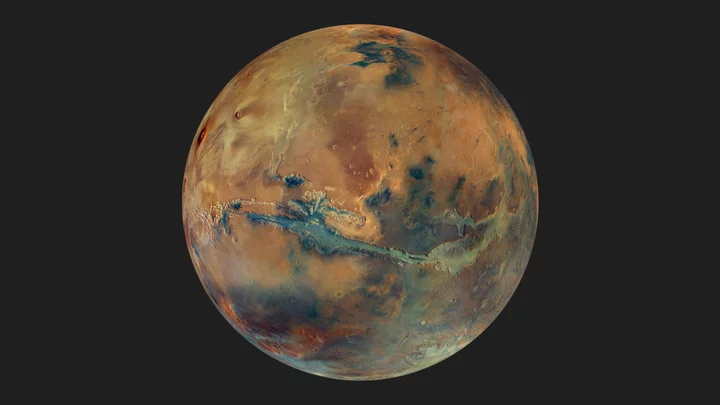For good reason, Mars has earned the nickname the Red Planet: Its ruddy color comes from high levels of oxidized iron, the same crusty stuff people observe on old, corroded metal.
But a new mosaic image of Mars shows Earth's neighbor as much more than a rusty sphere. With veins of contrasting colors running through it, you can start to see the world the way it probably once was — more Earth-like, laced with oceans and rivers rushing over its surface.
The European Space Agency produced this new photo using the High Resolution Stereo Camera (HRSC) on Mars Express, a spacecraft that has been orbiting the planet for two decades. The agency released the image to celebrate its 20 years of science. Gathering 90 images at altitudes of 2,500 to 6,400 miles above Mars, it captured swaths of terrain. The team then put the pictures together to make a global view.
SEE ALSO: An enormous Martian cloud returns every spring. Scientists found out why.Mars' changing atmosphere, sometimes rather opaque, has made it difficult to see the planet's surface colors from space in the past.
"Dust scatters and reflects light, causing colours to shift between images," the space agency said in a recent post. And when the mismatched pieces are put together, according to ESA, the result is usually patchy looking.
To overcome the color variation problem, engineers color-referenced every individual image, allowing them to keep each color intact and reveal a more complex and accurate view of Mars than has been possible before. Along with red, the planet shows areas of blue, gray, and black.
Mars Express, initially planned to conduct a two-year mission observing Mars, has been orbiting the red planet for 20 years. Credit: ESAThe large blue-toned areas get their hue from gray-black sands from volcanic activity. The wind carries the sand to form dark, imposing dunes that have been pockmarked with craters. The material weathered by water actually tends to look lighter, scientists say. Clay and sulfates, the two most common water-worn minerals present, indicate where liquid water flowed.
Want more science and tech news delivered straight to your inbox? Sign up for Mashable's Light Speed newsletter today.
The mosaic also captures immense detail in Valles Marineris, the biggest canyon in the solar system. The colossal gash stretches over 2,500 miles, 10 times longer than the Grand Canyon. In this region, a thin layer of dark sand covers salty minerals. But this close look gives scientists a chance to appreciate the color variations, with the brighter material peeking out.
The mosaic also captures immense detail in Valles Marineris, the biggest canyon in the solar system. Credit: ESA / DLR / FU Berlin / G. MichaelFor years researchers have found little signs that Mars used to be bathed in creeks and lakes. Martian water chiseled sinuous river beds and deep ravines into the ground now hollowed out and dusty. In the first year of NASA's Curiosity rover expedition, it sent home pictures of a stream bed, eroded and dry, with bountiful round pebbles, similar to those formed on Earth from flowing water.
The obsessive search for past water on Mars, a frozen desert, is a quest to prove the Red Planet was once wet, warm, and more Earth-like. Lakes and oceans could have been a key ingredient for supporting primitive Martian life, once upon a time, but this doesn't outright mean the environment was habitable.
By exploring former water sites, NASA hopes to find evidence of ancient microbial life. Earlier this year, the U.S. space agency found its clearest evidence yet of ancient water: rocks carved with ripples, the telltale fingerprints of water waves.
Mars Express has been observing the Red Planet since 2003. Over that time, it has studied the Martian surface, minerals, and its ever-changing atmosphere. It has orbited Mars 24,510 times and has taken nearly 7,000 pictures.
Through its lens, the spacecraft camera has captured wind-whipped ridges, sinkholes, craters, fault lines, river channels, and ancient lava pools.
In a video shared on Twitter by the German Aerospace Center, which provided the camera, planetary scientist Daniela Tirsch said the team hopes to continue working with the instrument over the next three to five years.
"I've fallen in love with our beautiful images over and over each day," she said.









